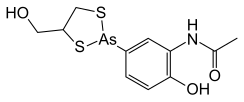Arsthinol

| |
| Names | |
|---|---|
| Preferred IUPAC name
N-{2-Hydroxy-5-[4-(hydroxymethyl)-1,3,2-dithiarsolan-2-yl]phenyl}acetamide | |
| Identifiers | |
3D model (JSmol)
|
|
| ChEBI | |
| ChEMBL | |
| ChemSpider | |
| DrugBank | |
| ECHA InfoCard | 100.003.965 |
| EC Number |
|
| KEGG | |
PubChem CID
|
|
| UNII | |
CompTox Dashboard (EPA)
|
|
| |
| |
| Properties | |
| C11H14AsNO3S2 | |
| Molar mass | 347.28 g·mol−1 |
| Pharmacology | |
| P01AR01 (WHO) QP51AD01 (WHO) | |
| Oral | |
| Pharmacokinetics: | |
| 89 % Hepatic[1] | |
Except where otherwise noted, data are given for materials in their standard state (at 25 °C [77 °F], 100 kPa).
| |
Arsthinol (INN) is an antiprotozoal agent. It was synthesized for the first time in 1949 by Ernst A.H. Friedheim by complexation of acetarsol with 2,3-dimercaptopropanol (British anti-Lewisite)[2] and has been demonstrated to be effective against amoebiasis and yaws. It was marketed a few years later by Endo Products (Balarsen, Tablets, 0.1 g).[3]
Among trivalent organoarsenicals, arsthinol was considered very well tolerated.[4] Recently, it was studied for its anticancer activity.[5][6]
Identification
[edit]Arsthinol has IUPAC name of N-[2-hydroxy-5-[4-(hydroxymethyl)-1,3,2-dithiarsolan-2-yl]phenyl] acetamide with a molecular formula of C11H14AsNO3S2 and is represented by the SMILES notation, CC(=O)NC1=C(C=CC(=C1)[As]2SCC(S2)CO)O.[7]
Properties
[edit]The molecular weight of Arsthinol is 347.3 g/mol, with a hydrogen bond donor count of 3 and a hydrogen bond acceptor count of 5. It has 3 rotatable bonds, an exact mass of 347.279 g/mol, and a monoisotopic mass of 346.963105 g/mol. The topological polar surface area is 120Ų, and the compound contains 18 heavy atoms. It has no formal charge, a complexity of 308, and contains no isotope atoms. There are no defined atom stereocenters, but there is 1 undefined atom stereocenter. The compound has no defined or undefined bond stereocenters, includes 1 covalently bonded unit, and is canonicalized.[8][9]
References
[edit]- ^ Cristau, B; Chabas, ME; Placidi, M (1975). "Voies et cinétiques d'excrétion de l'arsenic chez le Cobaye après injection de divers médicaments organo-arséniés". Ann Pharm Fr. 33: 577–89.
- ^ Friedheim, Ernst AH (1949). "A Five Day Peroral Treatment of Yaws with STB, a New Trivalent Arsenical". Am J Trop Med Hyg. s1-29 (2): 185–188. doi:10.4269/ajtmh.1949.s1-29.185. PMID 18116845.
- ^ Anonyme (1953). "New and nonofficial remedies; arsthinol". J Am Med Assoc. 152: 531.
- ^ Brown, CH; Gebhart, WF; Reich, A (1956). "Intestinal amebiasis: incidence, symptoms, and treatment with arsthinol (Balarsen)". JAMA. 160 (5): 360–363. doi:10.1001/jama.1956.02960400018005. PMID 13278204.
- ^ Gibaud, S; Alfonsi, R; Mutzenhardt, P; et al. (2006). "(2-Phenyl-[1, 3, 2] dithiarsolan-4-yl)-methanol derivatives show in vitro antileukemic activity". J Organomet Chem. 691 (5): 1081–1084. doi:10.1016/j.jorganchem.2005.11.007.
- ^ Becherirat, S.; Lanhers, M.-C.; Socha, M.; Yemloul, M.; Astier, A.; Loboda, C.; Aniceto, N.; Gibaud, S. (2013). "The antitumor effects of an arsthinol-cyclodextrin complex in an heterotopic mouse model of glioma" (PDF). Eur J Pharm Biopharm. 85 (3): 560–568. doi:10.1016/j.ejpb.2013.06.021. PMID 23831266.
- ^ PubChem. "PubChem". pubchem.ncbi.nlm.nih.gov. Retrieved 2024-10-17.
- ^ PubChem. "Arsthinol". pubchem.ncbi.nlm.nih.gov. Retrieved 2024-10-17.
- ^ "arsthinol | C11H14AsNO3S2". www.chemspider.com. Retrieved 2024-10-17.
